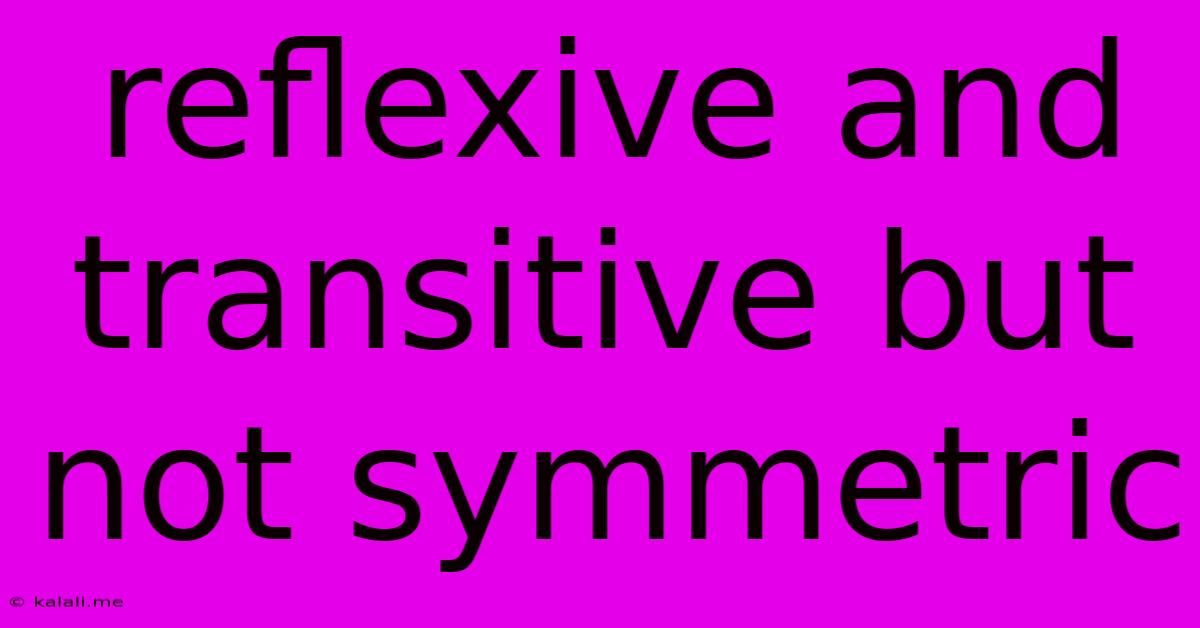Reflexive And Transitive But Not Symmetric
Kalali
Jun 01, 2025 · 3 min read

Table of Contents
Reflexive, Transitive, but Not Symmetric Relations: A Deep Dive
This article explores relations in mathematics that exhibit reflexivity and transitivity but lack symmetry. Understanding these properties is crucial in various fields, including discrete mathematics, computer science, and graph theory. We'll define each property, provide examples, and illustrate why a relation can possess two properties without the third. This will enhance your understanding of relational properties and their applications.
What are Reflexive, Symmetric, and Transitive Relations?
Before delving into the specifics, let's define the three key properties:
-
Reflexive: A relation R on a set A is reflexive if for every element a in A, (a, a) ∈ R. In simpler terms, every element is related to itself.
-
Symmetric: A relation R on a set A is symmetric if for every pair of elements a and b in A, if (a, b) ∈ R, then (b, a) ∈ R. If a is related to b, then b is related to a.
-
Transitive: A relation R on a set A is transitive if for every three elements a, b, and c in A, if (a, b) ∈ R and (b, c) ∈ R, then (a, c) ∈ R. If a is related to b and b is related to c, then a is related to c.
Reflexive and Transitive, but Not Symmetric: Examples and Explanations
The core of this discussion lies in relations that satisfy reflexivity and transitivity but fail the symmetry test. Let's explore some illustrative examples:
1. The "less than or equal to" relation (≤) on the set of real numbers:
- Reflexive: For any real number x, x ≤ x is true.
- Transitive: If x ≤ y and y ≤ z, then x ≤ z.
- Not Symmetric: If x ≤ y, it doesn't necessarily mean that y ≤ x. For example, 2 ≤ 5, but 5 ≤ 2 is false.
This is a classic example demonstrating the combination of reflexivity and transitivity without symmetry.
2. The "ancestor" relation on a set of people:
- Reflexive: A person is their own ancestor (considering themselves).
- Transitive: If A is an ancestor of B, and B is an ancestor of C, then A is an ancestor of C.
- Not Symmetric: If A is an ancestor of B, B is not an ancestor of A (unless it's the same person).
3. The "divides" relation (|) on the set of natural numbers:
- Reflexive: Every natural number divides itself (n|n).
- Transitive: If a|b and b|c, then a|c.
- Not Symmetric: If a|b, it doesn't imply that b|a. For instance, 2|4, but 4|2 is false.
Why is Symmetry Often Absent in These Cases?
The absence of symmetry in these examples stems from the inherent directionality or ordering implied by the relation. The relations aren't interchangeable; there's a clear sense of precedence or hierarchy. In the "less than or equal to" example, the order matters; in the "ancestor" relation, the lineage dictates direction; and in the "divides" relation, the divisibility itself establishes a non-symmetric relationship.
Conclusion:
Understanding the interplay of reflexive, symmetric, and transitive properties is fundamental in various mathematical and computational contexts. This article highlighted relations that possess reflexivity and transitivity but lack symmetry. Through clear examples, we illustrated how these properties can coexist, providing a deeper comprehension of relational properties and their applications within different mathematical structures. Recognizing these characteristics is essential for analyzing and working with various types of relations effectively.
Latest Posts
Latest Posts
-
Realeases Oh Ions Acids Or Bases
Jun 03, 2025
-
How To Rid Squirrels From Your Yard
Jun 03, 2025
-
Why Is The Film Called Seven Pounds
Jun 03, 2025
-
Power Series For Ln 1 X
Jun 03, 2025
-
How Much Does Car Engine Weigh
Jun 03, 2025
Related Post
Thank you for visiting our website which covers about Reflexive And Transitive But Not Symmetric . We hope the information provided has been useful to you. Feel free to contact us if you have any questions or need further assistance. See you next time and don't miss to bookmark.